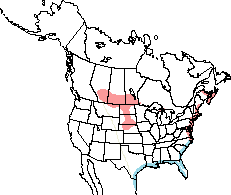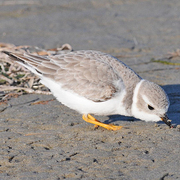Piping Plover
Charadrius
melodus
Charadriiformes
This is a large and highly varied group of birds that do not have many outward similarities. Most are water birds that feed on invertebrates or small aquatic creatures. The order is well represented in Washington, with seven families:
Charadriidae
Plovers are small to medium-sized shorebirds with round heads, short bills, large eyes, and short necks. They live on the ground in open habitats, mostly near water. They build a simple scrape nest on the ground, in which they lay 3–4 eggs. Both parents incubate and care for the young, although newly hatched chicks walk and feed themselves soon after hatching. Plovers eat small invertebrates, and their foraging style is what sets them apart from other shorebirds. Plovers are visual feeders: while foraging, they run, pause, eat, run, and pause repeatedly. This upright style contrasts with that of sandpipers, which are most often seen head down, probing for underground prey. Plovers also typically do not nest as far to the north as most sandpipers and do not migrate as far.
General Description
One record, at Reardan Ponds (Lincoln County) in July 1990.
North American Range Map


Family Members
 Black-bellied PloverPluvialis squatarola
Black-bellied PloverPluvialis squatarola American Golden-PloverPluvialis dominica
American Golden-PloverPluvialis dominica Pacific Golden-PloverPluvialis fulva
Pacific Golden-PloverPluvialis fulva Snowy PloverCharadrius alexandrinus
Snowy PloverCharadrius alexandrinus Semipalmated PloverCharadrius semipalmatus
Semipalmated PloverCharadrius semipalmatus Piping PloverCharadrius melodus
Piping PloverCharadrius melodus KilldeerCharadrius vociferus
KilldeerCharadrius vociferus Mountain PloverCharadrius montanus
Mountain PloverCharadrius montanus Eurasian DotterelCharadrius morinellus
Eurasian DotterelCharadrius morinellus

